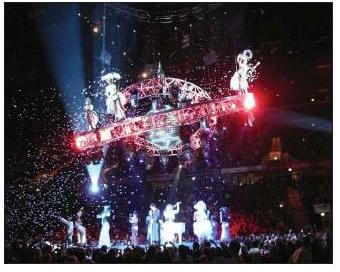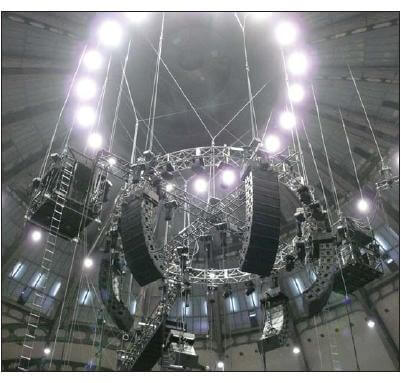Press releases

What a Beautiful World:
Rigging Solutions for Take That's German Dates
INDUSTRY NEWS
December 2007
 Take That, the British boy band, is currently on the Beautiful World tour, which started in Belfast in October and wraps on London on New Year’s Eve. The show has an elaborate scenic production designed by Ray Winkler, of Stufish, among them an end stage and B stage, requiring more than hundred rigging points. The set has three flown moving elements. A catwalk between the main and B stage is flown on 12 hoists. A flown ring in the B stage holds five dancers at one point in the show; a Barco MiPIX globe flies over the B Stage as well. (The set was built by Brilliant Stages.)
Take That, the British boy band, is currently on the Beautiful World tour, which started in Belfast in October and wraps on London on New Year’s Eve. The show has an elaborate scenic production designed by Ray Winkler, of Stufish, among them an end stage and B stage, requiring more than hundred rigging points. The set has three flown moving elements. A catwalk between the main and B stage is flown on 12 hoists. A flown ring in the B stage holds five dancers at one point in the show; a Barco MiPIX globe flies over the B Stage as well. (The set was built by Brilliant Stages.)
The tour played Germany for a series of dates running October 26-November 7. The production’s weight of 54 tons “goes over the limit of the standard capacities of most venues in Germany,” says Martin Gehring, of the German rigging company, Dart GmbH, which served as a consultant for these performances. One key piece of gear in facilitating the production, says Gehring, was the RON StageMaster, a wireless multi-load cell stage safety device for load control and overload prevention. The laptopbased system is a real-time load-map monitor that can be overlaid on stage plan layouts, such as AutoCad; this enables one to simultaneously monitor 16 individual hanging points, and make a summary of several groups and the entire structure.
The U.K.-based rigging company Summit Steel brought along the Ron StageMaster, although Gehring says Dart works with the system as well. Here, he says, it was used “above the B stage, making it possible to level the circular mothertruss in a way that made sure that its weight was divided properly between the twoton motors it hung off of. If you have eight 2-ton motors so close to each other, it takes only one wrong click on the control to almost overload a motor—and to take the motor next to it out of weight. It is also the only way to monitor the dynamic load in the system when you have moving trusses underneath it.”
 Gehring first encountered the Stagemaster while working on the Tel Aviv production of the musical Mamma Mia! “We like that it is a small device that’s easy to use,” he says; “to our knowledge, it’s the first working wireless load cell system for the entertainment industry. We have another load cell system, but its set-up needs a lot of knowledge and cabling; also, the cells are much bigger, so you lose more height when you put it between the motor and the load.” The need for such a product is growing, Gehring adds. “As shows get bigger and heavier, it is more and more necessary to document the weights properly, to get the approval from static engineers when you get close to the weight limitations of a venue.” The production’s lighting has been designed by Simon Tutchner, and features 80 Martin Professional Mac 2000 Wash units, 30 Mac 2000 Profiles, 70 Pulsar ChromaBlocks, 40 Clay Paky Alpha Halos, 40 Vari*Lite VL2000 Spots, 66 Pixelrange Pixel Pars, and a genuine World War II searchlight. Lighting gear was supplied by PRG Europe. In addition, the set features 250 sq. m. of Element Labs STEALTH LED displays, consisting of two columns—16 panels wide and 25 panels high—on either side of the stage, and one center column that’s 19 panels wide and 25 panels high; video images are supplied by via Green Hippo Hippotizers. Video gear was supplied to the tour by XL Video via Blink TV. Others involved in the production include Phil Broad (head of rigging) and Chris Vaughan (production manager). Before the final New Year’s Eve show, Take That will play 11 home town dates in Manchester.
Gehring first encountered the Stagemaster while working on the Tel Aviv production of the musical Mamma Mia! “We like that it is a small device that’s easy to use,” he says; “to our knowledge, it’s the first working wireless load cell system for the entertainment industry. We have another load cell system, but its set-up needs a lot of knowledge and cabling; also, the cells are much bigger, so you lose more height when you put it between the motor and the load.” The need for such a product is growing, Gehring adds. “As shows get bigger and heavier, it is more and more necessary to document the weights properly, to get the approval from static engineers when you get close to the weight limitations of a venue.” The production’s lighting has been designed by Simon Tutchner, and features 80 Martin Professional Mac 2000 Wash units, 30 Mac 2000 Profiles, 70 Pulsar ChromaBlocks, 40 Clay Paky Alpha Halos, 40 Vari*Lite VL2000 Spots, 66 Pixelrange Pixel Pars, and a genuine World War II searchlight. Lighting gear was supplied by PRG Europe. In addition, the set features 250 sq. m. of Element Labs STEALTH LED displays, consisting of two columns—16 panels wide and 25 panels high—on either side of the stage, and one center column that’s 19 panels wide and 25 panels high; video images are supplied by via Green Hippo Hippotizers. Video gear was supplied to the tour by XL Video via Blink TV. Others involved in the production include Phil Broad (head of rigging) and Chris Vaughan (production manager). Before the final New Year’s Eve show, Take That will play 11 home town dates in Manchester.








